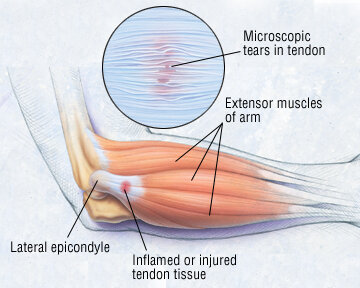Elbow Tendonitis Treatment Principles
An activity that is very repetitive or experiences high forces can lead to tendonitis, and in chronic cases, tendinosis. Tendonitis results from excessive or prolonged strain in a tendon or muscle, causing micro-tearing in the tissue that leads to adhesions and scar formation. Over time, the tissue quality is poor and resists basic treatment protocols such as RICE (rest,ice, compression and elevation). The scar tissue that has formed from the chronic micro-tearing is painful and unhealthy due to it having poor flexibility, poor capillary blood supply, and decreased tensile strength.

In climbers, extreme loads can be placed on the muscles and tendons in the forearm and elbow, leading to elbow tendonitis. Elbow tendonitis is also common in golfers, musicians, and tennis players.
Chronic tendonitis, also known as tendinosis or tendinopathy, needs active management to ensure proper healing. Rest itself will rarely work, as the tendon will remain weak and can experience further micro-tearing when you return to sport. Instrument Assisted Soft-Tissue Mobilization (IASTM) is extremely effective in treating chronic tendonitis. In addition, decreasing the load on the tendon through trigger point release techniques, dry needling, myofascial release, and active stretching are integral to the healing process. Progressive functional strengthening to properly load the healing tissue, and sport specific activity is a key component needed to help return the tendon to its proper strength. With patience, manual therapies, and progressive loading, the tendon will be able to handle the loads you wish to place on it with the sports you love.
Key Principles:
- Remodel the scar tissue into a healthier alignment of collagen fibers with the use of scar remodeling (IASTM) tools such as the Wave Tool
- Treat trigger points in the muscles in order to decrease the load on the healing tendon with foam rollers, trigger point balls, and massage.
- Work the tendon and muscle complex with eccentric muscle contractions, and use stretching to achieve a proper length-tension relationship
- Progressively and carefully load the remodeled scar tissue with sport-specific activities to improve tensile strength of the collagen fibers

